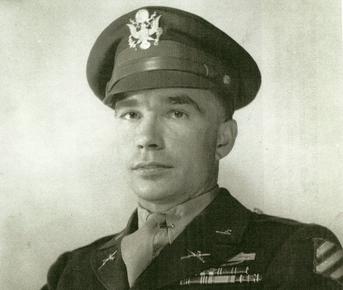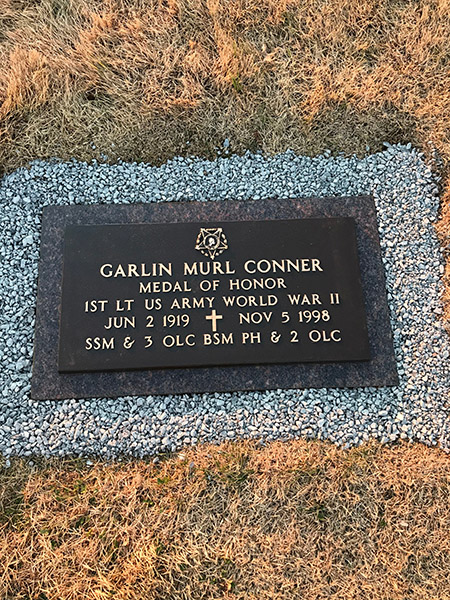Conner, Garlin Murl
- Date of birth:
- June 2nd, 1919 (Aaron/Kentucky, United States)
- Date of death:
- November 5th, 1998 (Albany/Kentucky, United States)
- Buried on:
- Memorial Hill Cemetery
- Nationality:
- American
Biography
Do you have more information about this person? Inform us!
- Period:
- Second World War (1939-1945)
- Rank:
- Sergeant
- Unit:
- Company K, 3rd Battalion, 7th Infantry Regiment, 3rd Infantry Division "The Rock of the Marne", U.S. Army
- Awarded on:
- 1943
Headquarters, 3d Infantry Division, General Orders No. 84
- Period:
- Second World War (1939-1945)
- Rank:
- Sergeant
- Unit:
- Company K, 3rd Battalion, 7th Infantry Regiment, 3rd Infantry Division "The Rock of the Marne", U.S. Army
- Awarded on:
- 1944
"On 30 January 1944, at about 0200 hours, near Ponte Rotto, Italy, Technical Sergeant Conner stormed a strongly fortified house, leading an assault group which he had organized, and succeeded in clearing it. Held by enemy soldiers armed with machine guns and machine pistols, the house blocked an attack being made by Company K. Four men previously sent to capture it were wounded. Taking a bazooka team and two rifle grenadiers with him, Technical Sergeant Conner led the way across 50 yards of exposed terrain and openly directed such effective fire on t he enemy at 25 yards range that one machine gun and two machine pistols were silenced and the crew of a fourth automatic weapon was routed. As a result, Company K continued its advance unhindered."
Headquarters, 3d Infantry Division, General Orders No. 87 (Bronze Oak Leaf Cluster)
Headquarters, 3d Infantry Division, General Orders No. 87 (Bronze Oak Leaf Cluster)
- Period:
- Second World War (1939-1945)
- Rank:
- 2nd Lieutenant
- Unit:
- Company K, 3rd Battalion, 7th Infantry Regiment, 3rd Infantry Division "The Rock of the Marne", U.S. Army
- Awarded on:
- January 11th, 1945
"On 11 September 1944, First Lieutenant (then Second-Lieutenant) Conner's fearless leadership under devastating enemy shell and small arms fire, resulted in the capture by his company of a road junction north of *****, France. Despite shells bursting within 10 yards of him, first hitting six men and later wounding three more, First Lieutenant Conner continued advancing and inspiring his platoon to follow him until he was approximately 300 yards from the enemy. He then crawled forward alone for about 250 yards through mortar, machine gun and rifle fire that barely missed him, and observed the enemy's dispositions. Leading his platoon by a covered route to the rear of the enemy, he launched a surprise attack that knocked out a machine gun and two mortars, killed three of the enemy, captured seven, and forced the remainder to flee."
Headquarters, 3d Infantry Division, General Orders No. 11 (Bronze Oak Leaf Cluster)
Headquarters, 3d Infantry Division, General Orders No. 11 (Bronze Oak Leaf Cluster)
- Period:
- Second World War (1939-1945)
- Rank:
- 1st Lieutenant
- Unit:
- S-2, 3rd Battalion, 7th Infantry Regiment, 3rd Infantry Division "The Rock of the Marne", U.S. Army
- Awarded on:
- February 10th, 1945
"On 3 February 1945, at 1700 hours, near *****, France, First Lieutenant Conner assumed command of a badly battered and disorganized rifle company and led it in an assault over 200 yards of fire-swept ground. Despite bullets which barely missed him, First Lieutenant Conner dashed forward with such grim ferocity that the enemy's morale was shattered. Closing in hand-to-hand combat he led his assault elements in killing 12 and capturing 75 of the enemy, totally shattering enemy resistance in the town."
Headquarters, 3d Infantry Division, General Orders No. 43 (Bronze Oak Leaf Cluster)
Headquarters, 3d Infantry Division, General Orders No. 43 (Bronze Oak Leaf Cluster)
- Period:
- Second World War (1939-1945)
- Rank:
- 1st Lieutenant
- Unit:
- Company K, 3rd Battalion, 7th Infantry Regiment, 3rd Infantry Division "The Rock of the Marne", U.S. Army
- Awarded on:
- February 10th, 1945
"For extraordinary heroism in action. On 24 January 1945, at 0800 hours, near Houssen, France, Lieutenant Conner ran four hundred yards through the impact area of an intense concentration of enemy artillery fire to direct friendly artillery on a force of six Mark VI tanks and tank destroyers, followed by six hundred fanatical German infantrymen, which was assaulting in full fury the spearhead position held by his Battalion. Unreeling a spool of telephone wire, Lieutenant Conner disregarded shells which exploded twenty-five yards from him, tearing branches from the trees in his path, and plunged in a shallow ditch thirty yards beyond the position of his foremost company. Although the ditch provided inadequate protection from the heavy automatic fire of the advancing enemy infantry, he calmly directed round after round of artillery on the foe from his prone position, hurling them back to the shelter of a dike. For three hours he remained at his OP [observation post] despite wave after wave of German infantry, which surged forward to within five yards of his position. As the last, all-out German assault swept forward, he ordered his artillery to concentrate on his own position, resolved to die if necessary to halt the enemy. Friendly shells exploded within five yards of him, blanketing his position, wounding his one assistant. Yet Lieutenant Conner continued to direct artillery fire on the assault elements swarming around him until the German attack was shattered and broken. By his exemplary heroism, he killed approximately fifty and wounded an estimated one hundred Germans, disintegrated the powerful enemy assault and prevented heavy casualties in his Battalion. Entered military service from Aaron, Kentucky."
Upgraded to MoH in 2018
Upgraded to MoH in 2018
- Period:
- Second World War (1939-1945)
- Rank:
- 1st Lieutenant
- Unit:
- Company K, 3rd Battalion, 7th Infantry Regiment, 3rd Infantry Division "The Rock of the Marne", U.S. Army
- Awarded on:
- June 26th, 2018
"On the morning of Jan. 24, 1945, 1st Lt. Garlin M. Conner was serving as an intelligence staff officer with the 3rd Battalion, 7th Infantry, 3rd Infantry Division, near the town of Houssen, France, when German formations converged on 3rd Battalion’s position.
With his battalion at risk of being overrun, Conner volunteered to run straight into the heart of the enemy assault in order to get to a position from which he could direct friendly artillery on the advancing enemy forces.
With complete disregard for his own safety, Conner maneuvered 400 yards through enemy artillery fire that destroyed trees in his path and rained shrapnel all around him, while unrolling telephone wire needed to communicate with the battalion command post. Upon reaching the battalion’s front line, he continued to move forward under the withering enemy assault to a position 30 yards in front of the defending U.S. forces. He plunged into a shallow ditch that provided little protection from the advancing enemy’s heavy machine gun and small-arms fire.
With rounds impacting all around him, Conner calmly directed multiple fire missions on to the force of 600 German infantry troops, six Mark VI tanks and tank destroyers, adjusting round after round of artillery from his prone position until the enemy was forced to halt their advance.
For three hours, he remained in this prone position, enduring the repeated onslaught of German infantry which, at one point, advanced to within five yards of his position. When the Germans mounted an all-out attack to overrun the American lines and his location, Conner ordered his artillery to concentrate on his own position, resolved to die if necessary to halt the enemy.
Ignoring the friendly artillery shells blanketing his position and exploding within mere feet, Conner continued to direct artillery fire on the enemy assault swarming around him until the German attack was finally shattered and broken. By his incredible heroism and disregard for his own life, Conner stopped the enemy advance. The artillery he expertly directed while under constant enemy fire killed approximately 50 German soldiers and wounded at least 100 more, thus preventing heavy casualties in his battalion."
Posthumously awarded
“We pay tribute to this Kentucky farm boy who stared down evil with the strength of a warrior and the heart of a true hero.”
— President Donald J. Trump
White House Ceremony, June 26, 2018
"There is no doubt that Lt. Conner should have been awarded the Medal of Honor for his actions. One of the most disappointing regrets of my career is not having the Medal of Honor awarded to the most outstanding soldier I've ever had the privilege of commanding."
— Maj. Gen. Lloyd B. Ramsey, Ret.
With his battalion at risk of being overrun, Conner volunteered to run straight into the heart of the enemy assault in order to get to a position from which he could direct friendly artillery on the advancing enemy forces.
With complete disregard for his own safety, Conner maneuvered 400 yards through enemy artillery fire that destroyed trees in his path and rained shrapnel all around him, while unrolling telephone wire needed to communicate with the battalion command post. Upon reaching the battalion’s front line, he continued to move forward under the withering enemy assault to a position 30 yards in front of the defending U.S. forces. He plunged into a shallow ditch that provided little protection from the advancing enemy’s heavy machine gun and small-arms fire.
With rounds impacting all around him, Conner calmly directed multiple fire missions on to the force of 600 German infantry troops, six Mark VI tanks and tank destroyers, adjusting round after round of artillery from his prone position until the enemy was forced to halt their advance.
For three hours, he remained in this prone position, enduring the repeated onslaught of German infantry which, at one point, advanced to within five yards of his position. When the Germans mounted an all-out attack to overrun the American lines and his location, Conner ordered his artillery to concentrate on his own position, resolved to die if necessary to halt the enemy.
Ignoring the friendly artillery shells blanketing his position and exploding within mere feet, Conner continued to direct artillery fire on the enemy assault swarming around him until the German attack was finally shattered and broken. By his incredible heroism and disregard for his own life, Conner stopped the enemy advance. The artillery he expertly directed while under constant enemy fire killed approximately 50 German soldiers and wounded at least 100 more, thus preventing heavy casualties in his battalion."
Posthumously awarded
“We pay tribute to this Kentucky farm boy who stared down evil with the strength of a warrior and the heart of a true hero.”
— President Donald J. Trump
White House Ceremony, June 26, 2018
"There is no doubt that Lt. Conner should have been awarded the Medal of Honor for his actions. One of the most disappointing regrets of my career is not having the Medal of Honor awarded to the most outstanding soldier I've ever had the privilege of commanding."
— Maj. Gen. Lloyd B. Ramsey, Ret.
- Period:
- Second World War (1939-1945)
- Period:
- Second World War (1939-1945)
- Period:
- Second World War (1939-1945)
- Period:
- Second World War (1939-1945)
- Period:
- Second World War (1939-1945)
- Period:
- Second World War (1939-1945)
- Period:
- Second World War (1939-1945)
- Period:
- Second World War (1939-1945)
- Period:
- Second World War (1939-1945)















